Glimpses of India NCERT Solutions | English Class 10 PDF Download
| Table of contents |

|
| Let’s Begin |

|
| Reading Comprehension |

|
| Vocabulary |

|
| Grammar |

|
| Editing |

|
| Listening |

|
| Speaking |

|
| Writing |

|
| Project |

|
Let’s Begin
In the ‘Glimpses of India’ (First Flight, Class X textbook, NCERT) you have read about interesting people and places. India is a place of diversity in terms of culture, language, food, traditions, etc. There are many stories unknown to us about the way of life of people. Work in groups of four and find out about the following in any five Indian states.- Their regional cuisine
- Dance form and music
- Art form
- Any other information
Mark these five places on a map and represent the information highlighting the interesting facts.
Reading Comprehension
Text IThe following is an excerpt about the Parsi community in India and their food. Read the passage and answer the questions.
“Aavoji, aavo, aavol Welcome to Delhi! Let me show you my beautiful city.” The booming voice of Nowrosji Kapadia could be heard across the length and breadth of the platform. It was Nowrosji’s favourite pastimd: a walk to the Old Delhi railway station to greet the Frontier Mail as it chugged into Delhi from Mumbai to Peshawar. With this refrain, an eager Nowrosji would cajole Parsi visitors off the train and take them home for a meal and often persuade some to stay overnight or for a few days. He would use this opportunity to tell them about the advantages of shifting to Delhi. Though his wife Jer Bai would occasionally object to unknown visitors, she was always overruled. This was the beginning of the community of Parsis in Delhi….
…Writing about Parsis in the Delhi of old is not easy. There are memories of my grandparents and parents – a collective memory of generations past and people long gone, yet here in spirit….
During festive gatherings, the women went to town with the food; outside catering was unheard of. The poorer members of the community never knew who had paid for what. This tradition continued in the northern cities of Lucknow, Kanpur, and Allahabad well into the ‘70s. Sadly, that kind of life has almost gone forever.
Food preparations began two days in advance. Dor ni pori (rich pastry stuffed with sweetened lentils) and malido (halwa) were carried in big vatus (pots) and served with puris. Anyone who has made malido can vouch for the fact that you need strong biceps; it is an exhausting exercise. The first time I made it under my grandmother’s supervision was also the last. I could hardly move my arms for the next two days! Since then, I gained a healthy respect for . my dainty grandmother.
The menu was extensive. Breakfast would start with either sev—brown vermicelli cooked in milk and served with fresh cream – or ravo, semolina pudding, Mithu dahi or sweetened curd made with full cream milk was an absolute must. This was followed by bafellaeeda, hard-boiled eggs, and kheemo kaleji, mutton mince with liver. For lunch, there was almost always smori dal chawal and macchi no patio — white boiled rice with yellow dal offset by a tart and tangy fish curry.
Teatime was special at our home. My grandmother made it a point to dress for tea; I was made to do the same. Once we were ready, out came the treats: Parsi biscuits – batasa; nan-khatai and flaky khari; patrel, rolled, steamed arbi leaves stuffed with besan masala-, kumas, rich Parsi cake; and my favourite, bhakra, sweet deep fried doughnuts. That tradition has stayed with me. I certainly don’t dress up, but I still need a snack with at least three cups of tea!…
(Source: ‘Down Memory Lane with the Parsis of New Delhi’, Shernaz Italiah, The Wire)
Q1: Infer the meaning of the following expressions
(a) Nowrosji would cajole Parsi visitors off the train.
(b) Jer Bai would occasionally object to unknown visitors, she was always overruled.
(c) …outside catering was unheard of.
(d) I gained a healthy respect for my dainty grandmother.
Ans:
(a) Nowrosji requested/persuaded the Parsi visitors to get down from the train and go with him to his house in Old Delhi.
(b) Jer Bai did not like unknown visitors in her home. She was against this practice but she was silenced by Nowrosji.
(c) Eating outside in a hotel or dhaba was not is practice then; people ate home made food only.
(d) malido making is an exhaustive exercise. When the author, under the supervision of her grandmother made it, she could not move her arms for two days. Seeing the exhaustion involved in it, she developed a particular kind of respect for her grandmother who made it frequently.
Q2: Answer the following questions.
(a) “Aavoji, aavo, aavo! Welcome to Delhi! Let me show you my beautiful city.” Who said this and why?
(b) Why were Jer Bai’s arguments always overruled?
(c) Why do you think outside catering was unheard of? ‘
(d) According to the writer what “kind of life has almost gone forever?
(e) What has made the writer more respectful to her grandmother?
(f) What was special about the tea time in the writer’s home?
Ans:
(a) Nowrosji used to say this on the Old Delhi Railway platform in order to take Parsi visitors home.
(b) Jer Bai’s arguments were overruled by Nowrosji because he was intensely inclined to persuade them to settle in Old Delhi.
(c) People might be having plenty of time to cook and eat. Hotels might be few in service. They possessed scanty money. Maybe they thought homemade food was more healthy and hygienic.
(d) During festive gatherings women went to town with food. They fed the poorer community. But their members never could conjecture who had paid for what. This tradition or the way of life has almost gone forever.
(e) Malido making was an exhaustive exercise which grandmother, out of love for children, undertook. When the author made it once her, arms became rigid for two days. Realisation of the difficulties in making malido made the writer more respectful to her grandmother.
(f) Tea time was special at the author’s home. Grandmother had made it a point to dress for tea. Once they were ready; out came the treats.
Q3: Tick the correct answer. What is “an
Ans:
(a) Preparing for the festival. ( )
(b) Travelling from Mumbai to Peshawar. ( )
(c) Writing about Parsis in old Delhi. ( )
(d) Cooking malido, the Parsi style halwa. ( )
Ans:
(a) X
(b) X
(c) X
b ✓
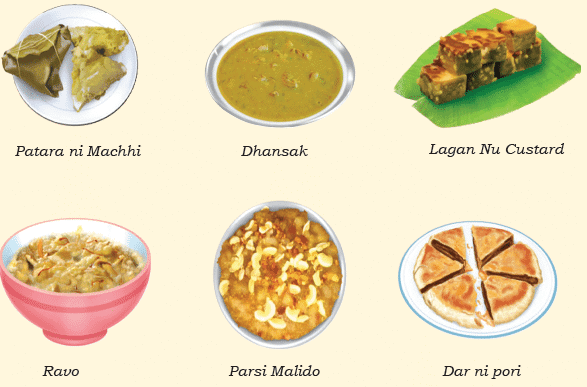
Q4: Make a list of Parsi delicacies as mentioned in the passage. A few are given above (in Workbook Page 87). You can add more to the list. Find the words for Mithu dahi in your language.
Ans:
List of Parsi delicacies:
Patara ni Machhi, Dhanshak, Lagan nu Custard, Ravo, Parsi Malido, Dar ni pori, sev, semolina pudding, Mithu dahi, bafellaeeda, hard boiled eggs, Kheemo Kaleji, mutton mince with liver, smori dal, chawal, machhi na patio, fish curry, parsi biscuits, batasa, nan khatai, flaky khari, patrel, rolled steamed arbi leaves, kumas, Parsi cake, bhakhra, sweet deep fried doughnuts.
Text II
You have read about Coorg, its rainforests, and coffee and tea from Assam in ‘Glimpses of India’ (First Flight, Class X textbook, NCERT). The following extract is about the cultivation of coffee in Araku valley in Andhra Pradesh. The story of Araku Valley traverses an unusual trajectory through Adivasi empowerment, hot-air balloons and some of the best coffee in the world.
Read the passage given below and answer the questions.
Located at about 1,200m above sea level, the valley, tucked away in the northeastern corner of Andhra Pradesh, shares a border with Odisha. For guests and participants at the Araku Balloon Festival (ABF), held between 18-20 January every year, this is sightseeing like nothing else.
The drive to far-flung coffee estates takes us through the five northern mandals of Anantha giri, Dumbriguda, Hukumpeta, Munchingi Puttu and Araku valley. The name Araku for the coffee was chosen simply because it sounded poetic. The view from the ground level is as impressive as the one from above – the landscape changes from densely forested hills to sweeping valleys and terrace farms surrounding occasional village clusters. The journey of Araku Coffee from a livelihood initiative by the Naandi Foundation to a globally appreciated product has been in the making for over a decade. It is also intrinsically tied to the history of how coffee arrived in this valley. It was a British civil servant, N.S. Brodie, who introduced coffee to these hill tracts in 1898.
Today, Araku coffee is a brand that works with 517 villages and 10,986 farmers, all of whom are estate owners and entrepreneurs with a stake in the business. The reason the coffee is of such high quality is that it follows the best practices of bio-dynamic farming by creating an interconnected and symbiotic ecosystem. The soil is enriched through composting and a variety of shade trees are planted, including cash-yielding fruit trees like mango and jackfruit. Terroirs are assessed and careful standard operating procedures are put in place from “sapling to savouring”, which ensures healthier plants and sweeter cherries and eventually a far superior coffee aroma and flavour.
(Source: ‘What’s Brewing in Araku Valley?’ by Diya Kohli, livemint, 23 Feb. 2019)
Q1: Infer the meaning of the following:
(a) traverses an unusual trajectory
(b) The drive to far-flung coffee estates
(c) densely forested hills
(d) village clusters
Ans:
(a) It means that the story of Araku Valley does not move in a straight line; instead it moves through different points of concern.
(b) It means that a journey by car to coffee estates which are located in remotest part of the land is cumbersome.
(c) It means that the hills there, are thickly afforested; many trees of many kinds are there to behold.
(d) It means that the villages there, are in groups surrounded by forests.
Q2: Find words from the text which mean the following:
(a) in a place that is hidden (paragraph one)
(b) distant or remote (paragraph two)
(c) to improve the quality or flavour of something (paragraph four)
(d) a smell specially a pleasant one (paragraph four)
Ans:
(a) tucked away
(b) far flung
(c) enriched
(d) flavour
Q3: Answer the following questions.
(a) What is unique about the Araku valley as stated in paragraph one?
(b) Where is Araku valley?
(c) Underline and write below the sentences, words, and expressions which indicate that Araku coffee has moved ahead of being the only means of livelihood.
(d) State a historical fact about the coffee in the valley?
(e) There are specific terms being used in the passage for the cultivation of coffee for example, terrace farms, biodynamic farming, etc. Find more such terms and their meanings.
Ans:
(a) bThe unique thing is that the story of Araku Valley traverses an unusual trajectory through Adivasi empowerment, hot air balloons and some of the best coffee in the world.
(b) Located at about 1200 m above sea-level, the valley is tucked away in the north eastern corner of Andhra Pradesh.
(c) Some lines are…
- The name Araku was chosen for the coffee for it being poetic.
- The journey of Araku coffee from a livelihood initiative to a globally appreciated product…
(d) The Araku coffee is a brand that works with 517 villages and 10,986 farmers…
bWords are bio dynamic, enterpreneurs, terroirs, trajectory, traverses, tucked etc.
Q4: The expression “sapling to savouring” in paragraph four means: (Tick the right answer)
(a) Coffee plants are taken care of from the stage of plantation till its beans are ready for an enjoyable cup of coffee. ( )
(b) Coffee saplings are very delicate hence a lot of care is being taken of them. ( )
(c) The growth of coffee plants is dependent on shady trees. ( )
(d) Coffee plant can give a cup of enjoyable coffee. ( )
Ans:
(a) ✓
(b) X
(c) X
(d) X
Vocabulary
Q1: Match the sounds in Column A with the appropriate words from Column B.
Example : rustling of silk
The meanings of some words are given below which will help you to find out the words.
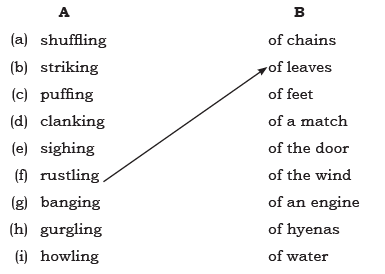
Ans: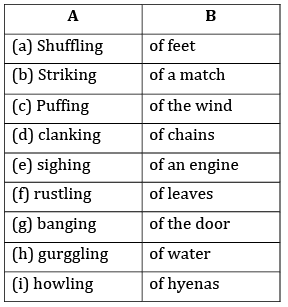
Grammar
Q1: You have read about-ing and -ed adjectives in the textbook, the First Flight, page number 97. Read it again to understand how these adjectives are used. These are also the present participles (-ing forms) and past participles (-ed forms) of verbs and are used as adjectives. Read the following sentences to know this.- Rita gave me a welcoming cup of coffee.
- Her performance in the test was pleasing.
- She appeared delighted with the gift.
- The bored students became restless.
Now fill in the blanks of the sentences with past participle from one of the following words.
(infect, take, quote, use, watch, frighten, propose)
(a) People demonstrated against the changes __________
(b) The loud cheer went up from the students __________
(c) After the editor read the article, she checked all the examples __________.
(d) Rub the antiseptic cream in the __________ area.
(e) My wallet was among the things __________.
(f) Cyclone Fani was a __________ experience.
Ans:
(a) proposed
(b) unwatched
(c) used
(d) infected
(e) taken
(f) frightening
Q2: Rewrite in the past tense the following excerpt from the ‘Glimpses of India’ (First Flight, Class X textbook) and check your answers with a partner. Birds, bees, and butterflies are there to give you company. Macaques, Malabar squirrels, langurs, and slender loris keep a watchful eye from the tree canopy. I do, however, prefer to step aside for wild elephants. The climb to the Brahmagiri hills brings you into a panoramic view of the entire misty landscape of Coorg. A walk across the rope bridge leads to the sixty-four acre island of Nisargadhama. Running into Buddhist monks from India’s largest Tibetan settlement, at nearby Bylakuppe, is a bonus. The monks, in red, ochre, and yellow robes are amongst the many surprises that wait to be discovered by visitors searching for the heart and soul of India, right here in Coorg.
Ans: Birds, bees, and butterflies were there to give you company. Macaques, Malabar squirrels, langurs, and slender loris kept a watchful eye from the tree canopy. I did, however, prefer to step aside for wild elephants. The climb to the Brahmagiri hills brought you into a panoramic view of the entire misty landscape of Coorg. A walk across the rope bridge led to the sixty four acre island of Nisargadhama. Running into Buddhist monks from India’s largest Tibetan settlement, at nearby Bylakuppe was a bonus. The monks, in red, ochre, and yellow robes were amongst the many surprises that waited to be discovered by visitors searching for the heart and soul of India, right here in Coorg.
Editing
Q1: Some words have been wrongly spelt in the paragraph given below. Correct the words and read the paragraph aloud.The Valley of Flowers The journey to the Valley of Flowers begins about 16 km away from Joshimath, at Govindghat (1,770 m) on the RishikeshBadrinath heightway. The Valley of Flowers is covered with a rich varity of magnifiscent plants.
Over the past few years, thousand of visitors have ‘discovered’ this idyll amidst the mountain. However, they live like marks only by way of empty cans, waste-paper and cigarete butts. Trakking in the area has resulted in the trampling of these delikate plants by humans and ponies. As a result, the government of India was compeled to ban all mountainering, trekking, expeditions and livestock grasing in the area, with effect from February 20, 1983. This is to privent further damage to one of our nation’s unique repositories of natural beauty.
Ans:
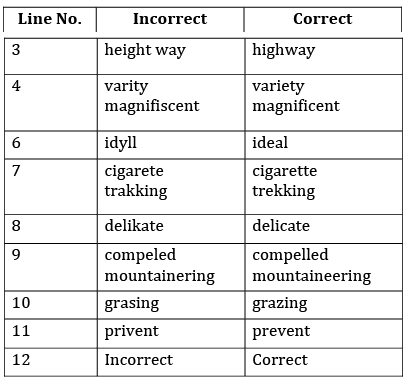
Listening
Ask your classmate or teacher to read aloud the following passage from the text ‘Glimpses of India’ (First Flight, Class X textbook). Listen carefully, and note down the keywords, main ideas and interesting expressions in your notebook while listening.During our childhood in Goa, the baker used to be our friend, companion and guide. He used to come at least twice a day. Once, when he set out in the morning on his selling round, and then again, when he returned after emptying his huge basket. The jingling thud of his bamboo woke us up from sleep and we ran to meet and greet him. Why was it so? Was it for the love of the loaf? Not at all. The loaves were bought by some Paskine or Bastine, the maid¬servant of the house! What we longed for were those bread-bangles which we chose carefully. Sometimes it was sweet bread of a special kind.
The baker made his musical entry on the scene with the ‘jhang, jhang – sound of his specially made bamboo staff. One hand supported the basket on his head and the other banged the bamboo on the ground. He would greet the lady of the house with a “Good morning” and then place his basket on the vertical bamboo.
We kids would be pushed aside with a mild rebuke and the loaves would be delivered to the servant. But we would not give up. We would climb a bench or the parapet and peep into the basket, somehow. I can still recall the typical fragrance of those loaves; loaves for the elders and the bangles for the children. Then we did not even care to brush our teeth or wash our mouths properly. And why should we ? Who would take the trouble of plucking the mango leaf for the toothbrush ? And why was it necessary at all ?
The tiger never brushed his teeth. Hot tea could wash and clean up everything so nicely, after all!
Now summarise the paragraph using your notes.
Ans:
During our child hood, the baker:
- was friend, companion and guide.
- visited twice a day.
- jingling thud of his bamboo woke us.
- we surrounded him for bread bangles.
- made a musical entry.
- greeted the lady with good morning.
- pushed aside the kids.
- delivered loaves to servants.
- Eager and impatient, we climbed a bench or the parapet.
- delivered loaves for elders and bangles for children
- we did not brush teeth – ate bangles.
Summary:
During our childhood, the baker was our friend, companion and guide because he delivered to us bread bangles. He visited our place twice a day. He made a musical entry and greeted the ladies with good morning. He delivered the loaves to elders and bangles to children. In impatience, we did not brush teeth and ate the bangles. After all the tiger too never brushes his teeth.
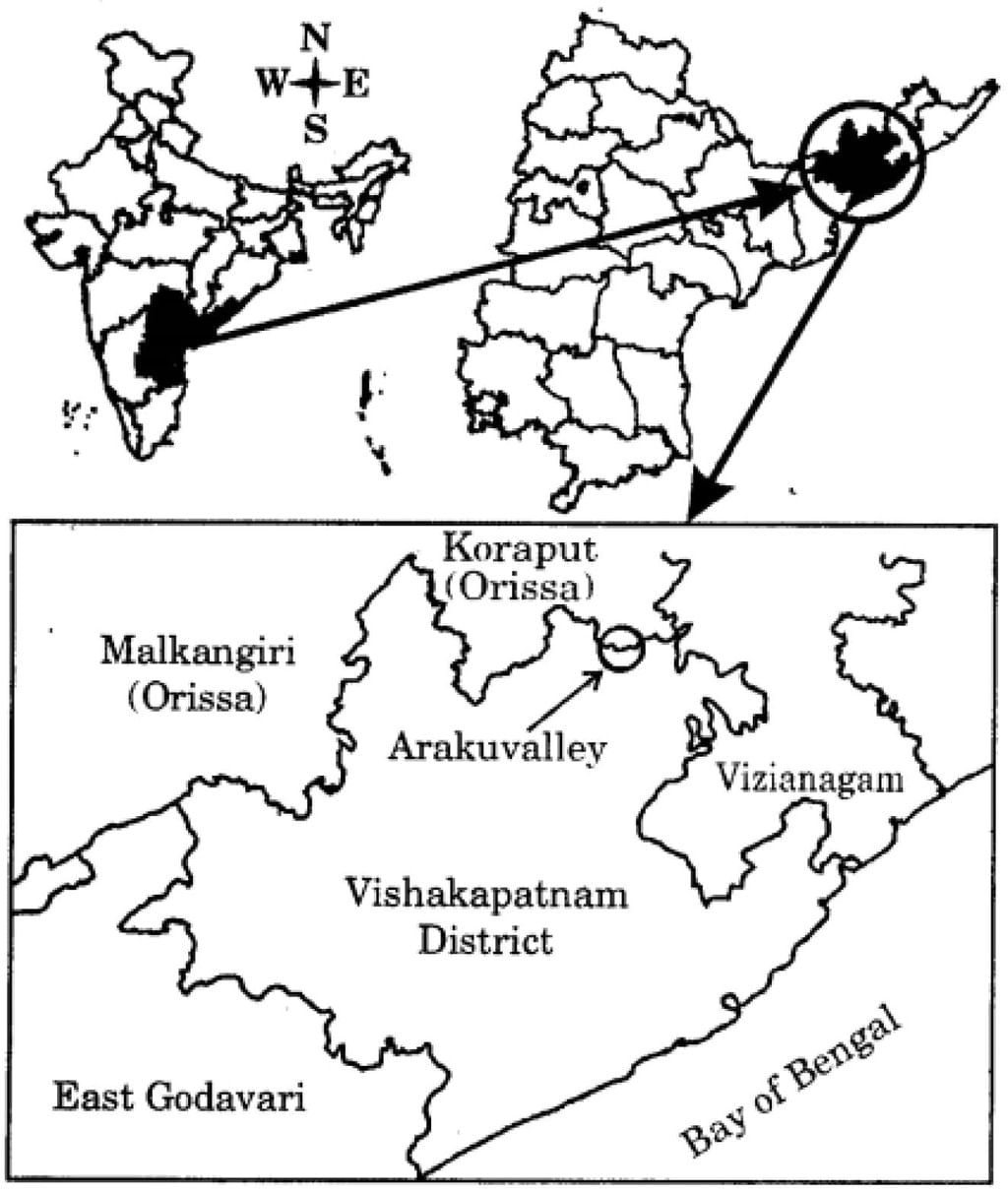
It is just a graphical representation. Map not to scale.
Speaking
Q1: Excursions give opportunities to explore nature, places of historical interest, etc. Tourists are interested in meeting people, understanding their culture, and enjoying the variety in food. The Indian Railways have recently introduced glass Vistadome coach in train to provide a delightful travelling experience to the picturesque valley of Araku in Vishakhapatnam.In groups of four, discuss and plan a budget trip to Araku valley. You may keep the following in mind while planning. Add more points to the following as per your requirement.
- Find out the location (look up the map) and accessibility to the places to be visited.
- Calculate the cost of the stay.
- Search for an economic and safe accommodation, perhaps a home stay.
- Find out the modes of transport and booking
Now, prepare an itinerary of your excursion to Araku valley and share with the class.
Ans:
- Location : Araku valley is a hill station in Vishakhapatnam district in Indian state of Andhra Pradesh lying 111 km west of Vishakhapatnam. This place is often referred to as Ooty of Andhra. It is a valley in the Eastern Ghats inhabited by different tribes.
- Places to Visit : INS Kurusura Submarine Museum, Borra Caves, Simhachalam Temple. Kailasagiri Park, Rama Krishna Beach, Araku Valley, Dushikonda Beach, Yarada Beach, Dolphin’s nose, Vuda Park, Sri Kanaka Mahalakshmi Temple, Kothopally Waterfalls, Kondkarla Ava Beach, Bheemunipatnam Beach, Matsya Darshini Acquarium, Katiki Falls, Sivaji Park etc.
- Per head cost of stay : ₹ 1750/ night (cheapest)
- Modes of transport and booking : Train; booking can be done online.
Q2: Try repeating some of these tongue twisters :
(a) Pre shrunk shirts
(b) Six slim slick slender saplings
(c) The sixth sheikh’s sixth sheep’s sick
(d) Tie twine to three twigs
(e) Double bubble gum bubbles double
Ans:
Do it yourself (Tongue twisters)
Writing
Q1: Infer the meaning of the following expressions in the passage on Parsi community. “Aavoji, aavo, aavo! Welcome to Delhi.”- length and breadth
- chugged into
- vouch for
- long gone
- out came the treats
Now, write an account of a travel by train using these expressions.
Describe the journey by giving details of distance, booking of tickets, facilities available, and suggestions for improvement. You can add pictures of places, people, etc.
Ans: “Aavoji, aavo, aavo! Welcome to Delhi.” means please come, come, come! You are welcomed in Delhi.
- length and breadth – the whole extent of
- chugged into – moved into, enter.
- vouch for – confirm (a truth/appropriacy)
- long gone – Something that is gone long ago.
- Out came the treats — grandmother brought on table many delicious things to eat.
An account of a travel by train.
From Pathankot to Miranda Station, H.P. it is around 60 km journey in length and breadth. Hardly had I reached the station when the toy train chugged into the platform; I got into it. Although I cannot vouch for total comfort in the train, I am sure, no one can feel boredom, because picturesque land around is replete with forests and at every other station, there are hawkers and vendors to fietch all you need. When did the train cross the border of the Punjab and entered into Himachal Pradesh, I could not notice due to my deep involvement in outside scenery. Long gone were the hustle and bustle of the Punjab and the serenity and tranquillity were spread all over. I reached my sister’s house and got fresh. Then out came the treats with a steaming cup of coffee; I felt I am in heaven.
Palampur is a beautiful place where mountain peaks at a distance remain covered with snow always. It takes 6 hrs to reach there from Pathankot. Ticket booking is similar to the ordinary train ticket booking. So far the facilities are concerned, one can book a ticket in first class compartment. Rest everything is same. The Railways should come up with some good trains which run faster and look nicer. A waiting hall should be constructed there for the passengers.
Q2: Write an advertisement for your favourite tea or coffee.
Ans:
Poster: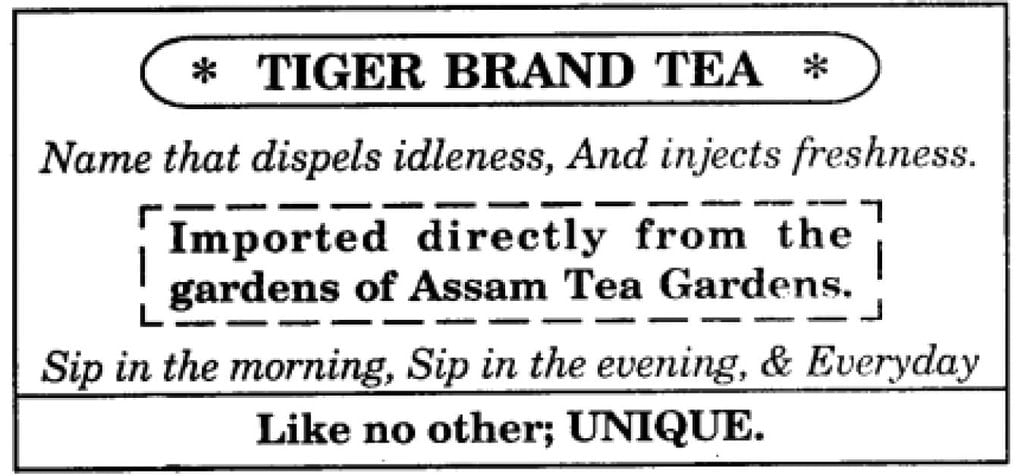
Q3: You have read about breads and bakers in Goa. (First Flight, Class X). Traditional breads are famous in Kashmir as well. It is said that a Kashmiri’s day starts with a cup of piping hot nun chai (salty pink tea) and a crisp, freshly baked bread from the Kandur (the traditional baker). In Kashmir, the Kandur shop isn’t just a place where one goes to buy the morning and evening breads, it is a social hub. It is a place where you get to hear and participate in discussions that range from gossip to political discourses. The Kandur shop or Kandur waan as it is called in Kashmiri has variety of breads for different occasions that are baked in the Kandur’s oven.
Read about some of the Kashmiri breads:
→ Tsot-Girda : is a medium sized round everyday bread that is a must on every breakfast table in Kashmir.
→ Lavasa : is a puffy level bread made from maida.
→ Tsochwor or Tilvor : is a bagel shaped, slightly hard bread with a sprinkling of sesame seeds on top. The baker prepares ‘tsochwor’ at noon time to be enjoyed with the afternoon tea.
→ Kulcha : These are crispy palm-sized breads sprinkled with poppy seeds. These are mith (sweet) and namkeen (savoury). The bread is taken with some traditional Dodh Kehva (rifilk Kehva).
→ Sheermal : is another type of bread from Kashmir. It is mildly sweet.
→ Roath : The sweet bread with a cake like texture is baked in traditional tandoor and is topped with dry fruits. However, this one bread is made for grand occasions like weddings, child birth or engagements and served with Kehva.
- Now, collect information about breads,parathas, rotis in different parts of the country.
- You can talk to peers, teachers, parents, grandparents, community members and make use of internet.
- Make an interesting collage using pictures and write a few sentences about each brfead based on the information you have gathered.
Ans:
→ Information collected about breads, rotis and Parathas:
It is most often made from wheat flour, cooked on a flat or slightly concave iron griddle called tawa. Traditionally rotis have also been made from the flour of millet, corn, jowar and even rice. Like breads around the world, roti is a staple accompaniment to other foods. Parathas are similar to rotis; they are sometimes stuffed with vegetables.
→ Variations : Chapati, Makki di roti, rumali roti, tandoori roti, wrap roti.
→ main ingredients : Atta (wheat) flour.
→ place of origin : Indian subcontinent.
→ Different types of bread prevalent in India
- Roti: The rotis that we eat daily is a kind of bread which is made from wheat flour mainly.
- Poori: This is too a bread; it is made on happy occasions. Poori is unleavened and made with whole wheat dough and is deep fried.
- Luchi : This is almost like Poori; it is more popular in Bengal and uses refined flour instead of whole wheat flour.
- Paratha : Paratha separates into layers. Its shape differs. Some of them are stuffed with veggies to meat.
- Naan : This is soft spongy leavened bread which came to India from central Asia. It is cooked in tandoor; milk instead of water is used to knead the dough.
- Kulcha : It is punjabi variation of naan; it is a leavened flat bread made with refined flour and cooked in tandoor.
- Appam: This is a south Indian flat bread made with rice and coconut milk batter. It has several variations.
- Bhaturft : -Deep fried and served with chole, this leavened bread is crispy and much larger in size than poori.
- Puran Poll: A popular Maharashtrian delicacy, it is a kind of paratha stuffed with chana dal, jaggery and coconut mixture and then cooked with ghee.
- Sheermal: An inseparable part of traditional Awadhi and Nizami cuisine, Sheermal is a leavened bread cooked in tandoor. It is flavoured with saffron and has a mildly sweet taste.
- Bakarkhani: It is a leavened bread and has a biscuit like texture. It is mildly spiced, is sweet and flavoured with saffron. It is a part of Eid celebrations.
- Pathiri: This white, thin pancake made with rice flour is popular with Malabari Muslims and is an essential part of iftaar during Ramzaan.
- Parotta : It is a layered flat bread mid way between Lachha paratha and tikona Paratha and is popular in Kerala.
- Lachha Paratha : It is a round bread that has several layers which are made by applying ghee while rolling the dough.
- Roti/Chapati: Round and soft, roti or chapati is made with whole wheat flour and is part of our daily diet.
- Bhakri : Hard and crisp, it is an unleavened bread made with flour and is popular in Maharashtra, Goa and Gujarat.
- Tandoori roti: Similar to naan, this bread is made of whole wheat and is cooked in clay oven at a high temperature.
- Baati: It is a Rajasthani preparation served with daal and choorma.
- Litti: It is a popular Bihari dish. It looks like a ball which is baked in clay oven and is stuffed with Sattu. It is served with chokha made with brinjal and potatoes.
- Kachori : Kachori is a festival item; it is thicker than poori. It is stuffed with a variety of ingredients.
- Thalipeeth : It is made with rice, wheat, jowar, bajra, urad and chana. It is spicry and savoury.
- Thepla : Made with whole wheat flour, gram flour, fenugreek leaves and spices, this Gujarati bread is soft and has a longer shelf life than most breads.
Project
Q1: The Frontier mail, the train mentioned in the passage on the Parsi community was the prestigious and luxurious train which was flagged off in 1928 from Bombay to Peshawar. It was the fastest train known for its punctuality. It covered the distance of 2,335 kms in record time of seventy two hours.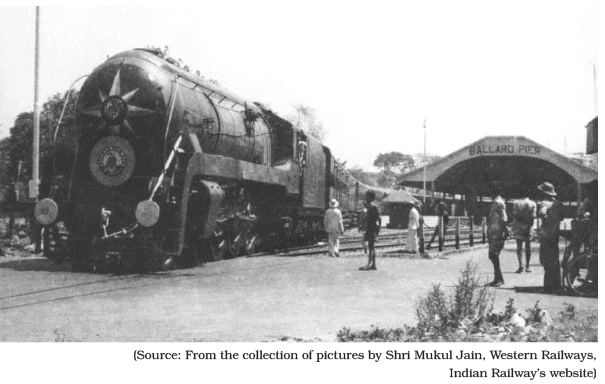
The train used to depart from Ballard Pier Mall Station at Bombay harbour for passengers arriving from England by ship and for the collection of mail brought in from steamers from Europe. It was fashionable to travel by Frontier Mail in those days!
- Our railways have undergone magical transformation since independence from electrification to high speed etc. Find more about Indian Railways and prepare a write up. You can add experiences of rail travel of the people.
- Collect the pictures and information about vintage, royal and luxury trains in India.
Ans:
A write-up on the Indian Railways:

Founded on 8th May 1845, the Indian Railways is India’s national railway system operated by the Ministry of Railways. It is the fourth largest network in the world by size. It has a route length of 67,368 kilometre and total track length of 121,407 kilometre as of March 2017. Routes are electrified with 25 KV AC electric traction while thirty three per cent of them are double or multi-tracked.
More than 20,000 passenger trains are run by the Indian Railways daily on long distance as well as on suburban routes from 7,349 stations across India. All the trains have been a 5 digit number for identification. The most common type of trains mail or express – run at an average speed of 50.6 kilometres per hour. The Indian Railways runs more than 92,000 trains daily in the freight segment; these trains run at an average speed of 24 kms per hours.
The Indian Railways consists of 277,987 freign wagons, 70,937 passenger coaches and 11,452 locomotives. At several places in India, the Indian Railways has coach production and locomotive facilities. Being the world’s eighth largest employer, it has 1,308 million employees as on March 2017.
In the year that ended on March 18, the Indian Railways carried 8.26 billion passengers and transported 1.16 billion tonnes of freight. In the fiscal year 2017-18, the Indian Railways is projected to have revenue of 1.874 million consisting of 1.175 trillion in freight revenue with an operating ratio of 96.0 per cent.
Information and Pictures About Luxury Trains:
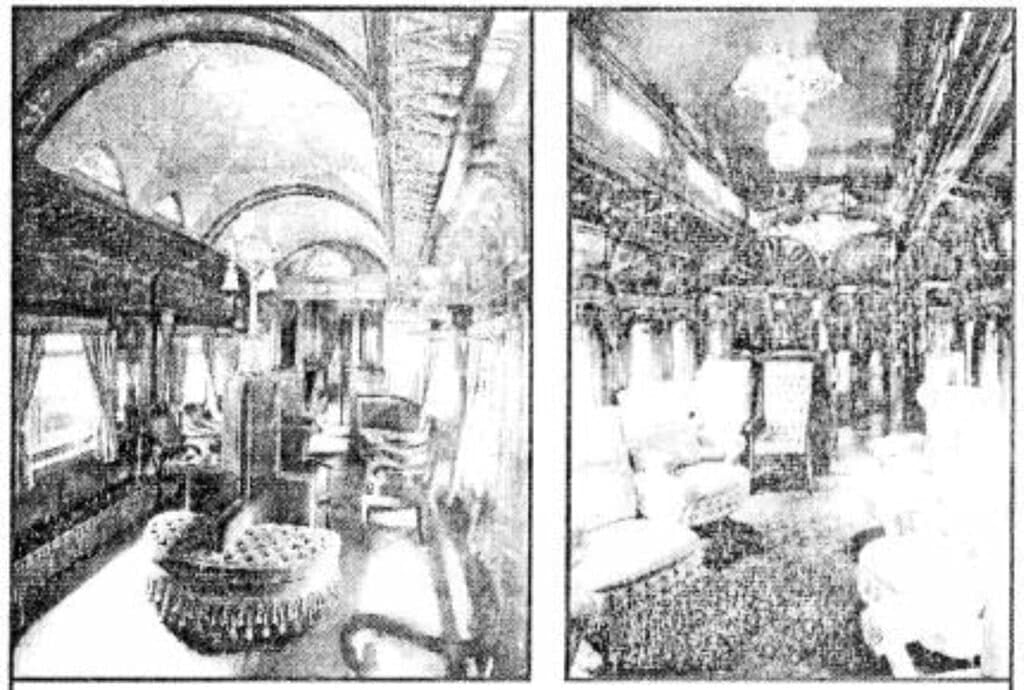
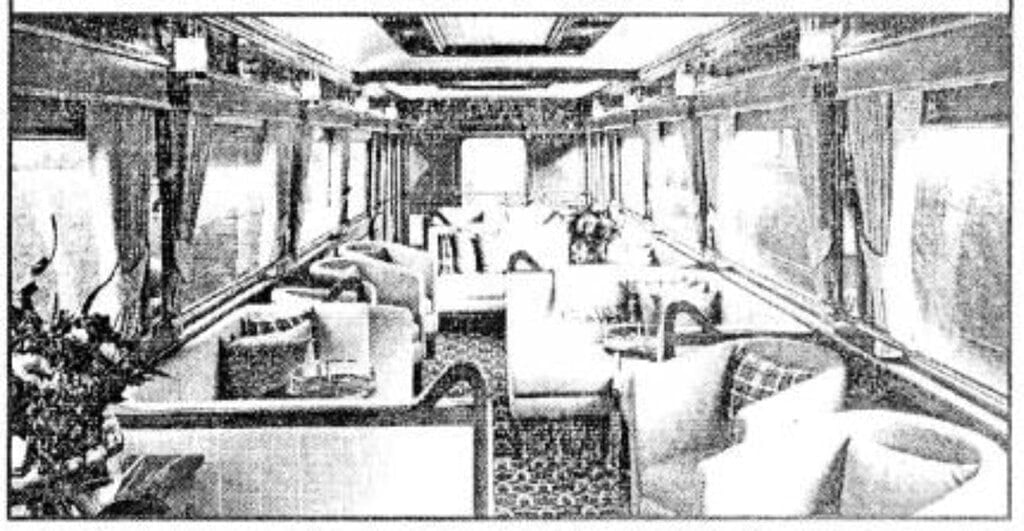
Luxury trains are designed to offer a very comfortable ride and evoke an association with history and heritage. Operating in several countries, they are premium, travel option. Although some luxury trains promote tourism in destinations across continent, others such as Maharaja Express take passengers on a long, leisurely ride through a single country.
Although air travel can be monotonous, passengers on a luxury train can see the local environment, social and economic conditions and a myriad of colours during their travels. Unlike airplanes, luxury trains are spacious, and have restaurants and bars, comfortable seating and sleeping areas and bathrooms.
Information And Pictures about Royal Trains:
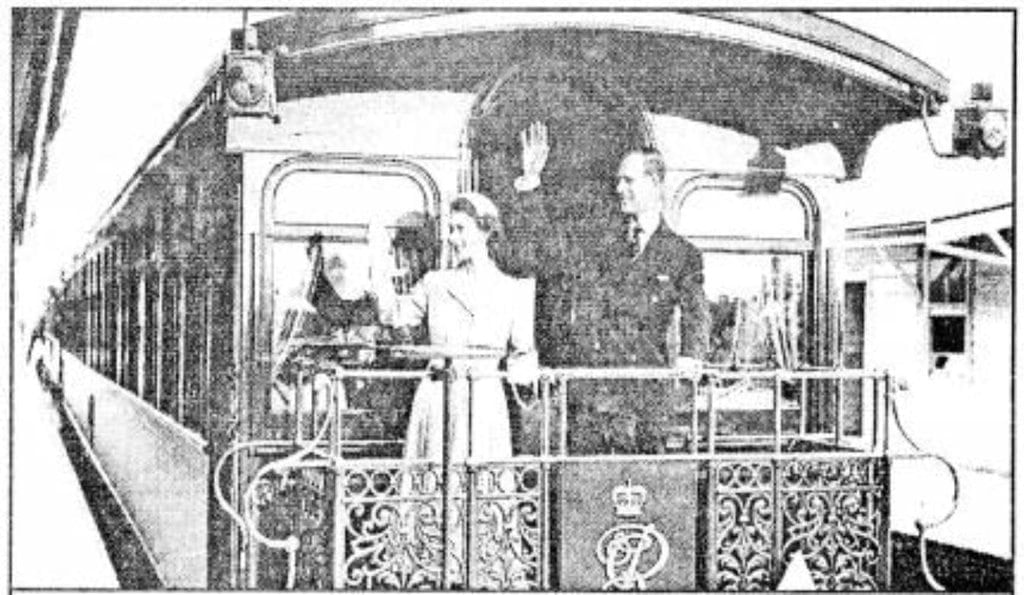
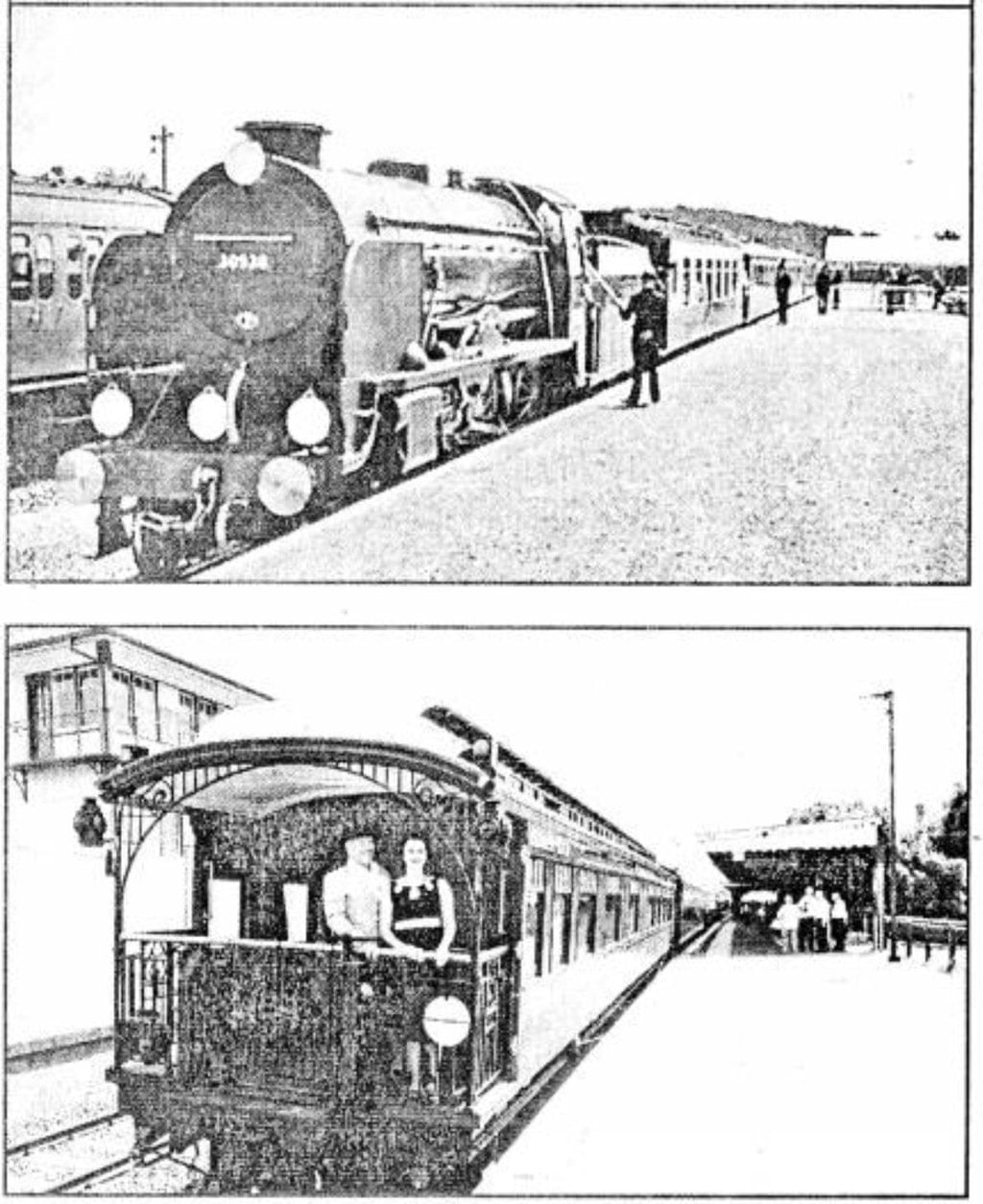
The British Royal Train is used to convey senior members of the British Royal family and associated staff of the Royal Household around the railway network of Great Britain. Owned by Network Rail, it is maintained and operated by DB Cargo UK.
Information and Pictures About Vintage Trains:

A steam locomotive is a type of railway locomotive that produces its pulling power through a steam engine. Steam engines were first developed in United Kingdom during the early 19th century. Richard Trevithick built the first steam locomotive in 1802. The first commercially successful steam locomotive was built in 1812-13 by John Blenkinsop. Locomotion No. 1 built by George Stepheson and his son Robert’s company Robert stephenson and company was the first steam locomotive to haul passengers on a public railway, the stockton and Darlington Railway in 1825. In 1830, George Stephenson opened the first public inter-city railway, the Liverpool and Manchester Railway.
|
61 videos|617 docs|69 tests
|




















